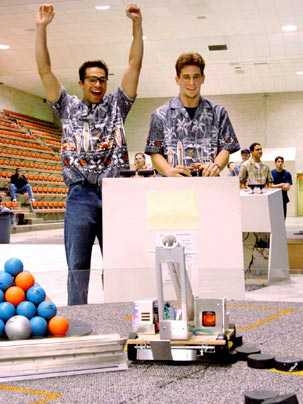MIT's 35th annual festival of anguish, elation and extreme engineering--the 2.007 Mech E Design Contest--takes place on May 12 and 13 at 6 p.m. in Johnson Athletic Center.
The mother of all robot contests, 2.007 has been replicated worldwide in engineering schools and on television. This week, visitors and robot contest fans have a unique chance to view a video history of 2.007 and to get an insider's preview of the 2005 contest in an inauguration week event, "Learning by Design," to be held Thursday, May 5, from 1 to 3 p.m. in Building 10-250.
Alexander Slocum, professor of mechanical engineering and MacVicar Fellow, emcees the two-night elimination tournament every year. For "Learning by Design," Slocum will comment on the 2.007 experience and on the types of contest entries he's seen--from "bulldozers" to "extendo lazy-tongs bifurcated doo-hoppers." The event will open with a video of contestants from past competitions biting their nails and shouting for joy.
Meanwhile, down in the Pappalardo Lab (Building 3-030), students are revving up for the final rounds of this year's contest on May 13th. The annual 2.007 contest concludes the mechanical engineering course Design and Manufacturing I, taught by MIT faculty and staff under Slocum's direction. The contest is a final exam, "two evenings of reality-meets-theory. This is when physics hits the road," said Slocum.
Inside 2.007
Course 2.007 begins in February, when each one of 130 students in the class is given a kit of nearly 100 items ranging from electric motors to structural elements (wooden slats, aluminum sheets, steel rods, plastic tubing, rubber bands) to springs, gears and bearings.
Machines designed and built for 2.007 must fit into a box roughly the size of a picnic hamper. On contest night, each machine has 45 seconds to complete certain tasks--gathering plastic bottles, ping-pong balls or hockey pucks, moving glass marbles, or playing tug of war--while a competing machine does the same tasks within the playing area. The final rounds of 2.007 are invariably crowd-pleasers.
The 2.007 contest (originally the 2.70 contest) evolved from a 1970 "creativity kit," developed with the help of then-graduate student Woodie S. Flowers, now MIT's Pappalardo Professor of Mechanical Engineering.
Contests are named annually. "A Better Mousetrap" occurred in 1972. Since then, 2.007 titles have ranged from the political ("Watergater," 1974) to the pop-cultural ("The Cuckoo's Nest," 1988) to the extreme-environmental ("Ballcano," 1997; "MechEverest," 1998). This year's "Tic Tech Toe" is inspired by the façade of Simmons Hall.
Motor memory
Each round of the contest is a mere sliver of time, but those seconds can affect a lifetime. No one seems to recover from 2.007. Past winners and contestants who returned to MIT to celebrate the contest's 30th birthday in 2000 spoke about the course as if they were still competing. Some keep portraits of their robots handy, like family pictures. Others brood on retooling for victory.
"It is the purest form of design you will ever experience. It changed my perception on engineering and design, as well as my own ability and confidence," said Aaron G. Flores (S.B. 1991, S.M., Ph.D.) winner of "Not in My Backyard," 1989.
"I cheer myself up by recalling that I won 2.007, and when I speak to alumni I refer to winning as the highlight of my academic career," said Brian G. R. Hughes (S.B. 1977), Alumni Association president 1999-2000 and winner of "The Great Can Test" in 1976.
"Sometimes I still have nightmares," said George S. Lechter (S.B. 1975, S.M.), winner of "The Great Water Waiter Race," 1972.
Thomas H. Massie (S.B. 1993) returned to compete in an anniversary alumni contest in 2000, seven years after his victory in "Pipe Dreams." Massie and his wife, Rhonda, worked for three days and nights to build a silvery one-armed rock-sweeper for the battle. The Massies' machine was fierce, but not triumphant.
But the spell doesn't wane. As Massie and his family packed up to leave Johnson, the 2.007 veteran surveyed the familiar scene--cables running every which way, elated students shouting, children chasing street hockey balls--with happiness. For an engineer, there's something irresistible about building, rebuilding and starting all over again.
A version of this article appeared in MIT Tech Talk on May 4, 2005 (download PDF).







